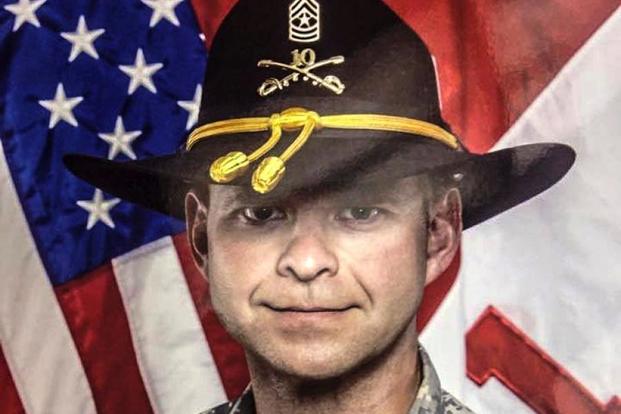Members of the U.S. Army's Security Force Assistance Brigades are trained to form tight bonds of trust with foreign counterparts, a culture that set the conditions for Command Sgt. Maj. Timothy Bolyard to lose his life in a 2018 green-on-blue attack in Afghanistan, an Army investigation shows.
On the morning of Sept. 3, 2018, Bolyard and his fellow soldiers from the Headquarters, 3rd Squadron, 1st SFAB were visiting Forward Operating Base Maiwand in Logar province, Afghanistan. They planned to attend a local meeting, or shura, with the commander of the 4th Brigade, 203rd Corps of the Afghan National Army on the topic of election security.
Read Next: The Army Is About to Get its First Female Green Beret
Conditions were peaceful. SFAB members had removed personal protective equipment such as body armor as a show of trust to their Afghan counterparts.
The quiet afternoon changed drastically at 12:10 p.m. when a gunman with the Afghan National Police opened fire on the Americans as they walked with ANA members to the nearby dining facility. That's according to an AR 15-6 Army command investigation of the attack, dated Oct. 10, 2018. Military.com obtained a redacted copy of the report through a Freedom of Information Act request. Military Times was first to report on the investigation's findings.
One gunman fired a short burst from his AK-47 rifle. The second assailant opened up with his PKM light machine gun, firing two bursts of approximately four to six rounds each toward the Americans, the report states.
Both U.S. and Afghan troops scattered along the narrow path to the dining facility, trying to find cover and locate the origin of the gunfire.
Bolyard, who was walking with a second group of personnel, was hit, the report states.
"He was shot while moving to cover," according to the investigation. "Witnesses observed CSM Bolyard draw his pistol, turn around toward the Shura and then turn back toward the [dining facility] before falling to the ground.
"CSM Bolyard was not wearing any of his PPE or body armor."
SFAB soldiers told investigators later that they were unable to locate where the gunfire came from because it ended abruptly, according to the investigation.
Bolyard's fellow soldiers rushed to his side to administer first aid.
"CSM Bolyard was lying on his stomach in an awkward position, indicating possible spinal injury and struggling to breathe," according to the investigation. First responders found a bullet had entered his upper middle back, with no exit wound.
They put a chest seal over the wound, but Bolyard was still having trouble breathing.
"They noticed an unevenness in his chest cavity, indicating a collapsed lung," the report states.
The unit's quick reaction force arrived on scene in minutes and Bolyard was loaded into a Mine Resistant Ambush Protected vehicle, or MRAP, for transport to a nearby forward surgical team. Bolyard arrived at nearby FOB Dahlke-East at 12:38 p.m., but "had no pulse and no cardiac activity," the report states.
Medical personnel attempted to stop the bleeding and restart his heart, but their efforts failed. He was pronounced dead at 1:24 p.m., according to the investigation report.
"There were no significant delays in the medical process," the report states.
Bolyard, 42, joined the Army in 1994 and in his career was the recipient of six awards of the Bronze Star, two of them with combat "V" device for valor.
Another soldier was wounded in the attack when he took a round to the back of his ballistic helmet. "Although the bullet did not fully penetrate his helmet, the impact of the round indented the back of the helmet," the report states.
The investigation is heavily redacted and the recommendations in the report are not releasable to the public, Arnell Credle Jr., a FOIA analyst for Third Army and U.S. Army Central, told Military.com.
Prior to the attack, the threat level was assessed as moderate, "with no known or reported incidents of green-on-blue in historical reporting at FOB Maiwand, the report states, adding that SFAB leaders made a calculated decision to allow advisors to move without body armor after considering the environment.
"None of the witnesses noticed any suspicious behaviors or insider threat indicators during the Shura," according to the report. "No one reported any tensions or arguments between U.S. personnel and their Afghan partners."
After the attack, ANA leaders discussed the incident and "determined that the ANA [personal security detail] personnel were the perpetrators," the investigation states.
All ANA and ANP leaders told their American counterparts they would cooperate fully with any investigation and "showed great remorse following the incident," the report states.
ANA soldiers witnessed the two shooters open fire, but no one "knew the individuals who committed the attack," according to the report. "None of the witnesses knew why the attack was committed."
The two shooters and their two accomplices were able to leave the FOB in the confusion but were apprehended at 6:50 p.m. that evening, according to the report.
The SFAB advisors were "trained extensively on countering insider threats" during pre-deployment training both at the Army's Joint Readiness Training Center at Fort Polk, Louisiana and at their home station at Fort Benning, Georgia, the report states.
"Insider threats are the number-one risk associated with the [train, advise and assist] mission and was constantly discussed and trained for throughout the deployment as it was considered the enemy's most dangerous course of action for every mission and location," according to the investigation.
-- Matthew Cox can be reached at matthew.cox@military.com.
Related: Soldier Killed in Insider Attack Was SFAB Command Sergeant Major













